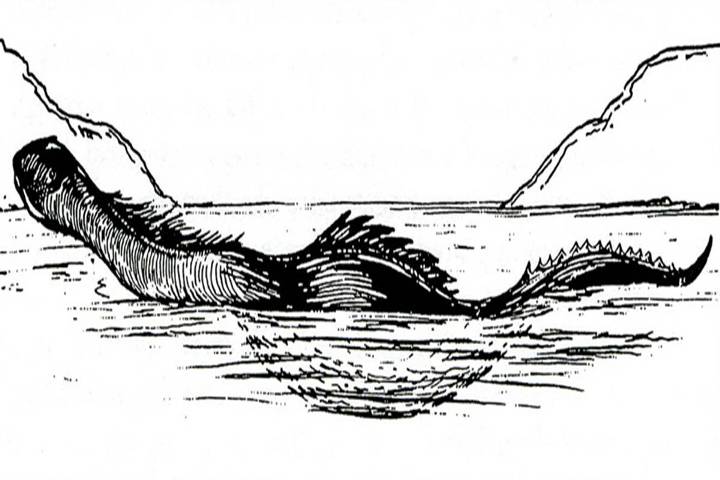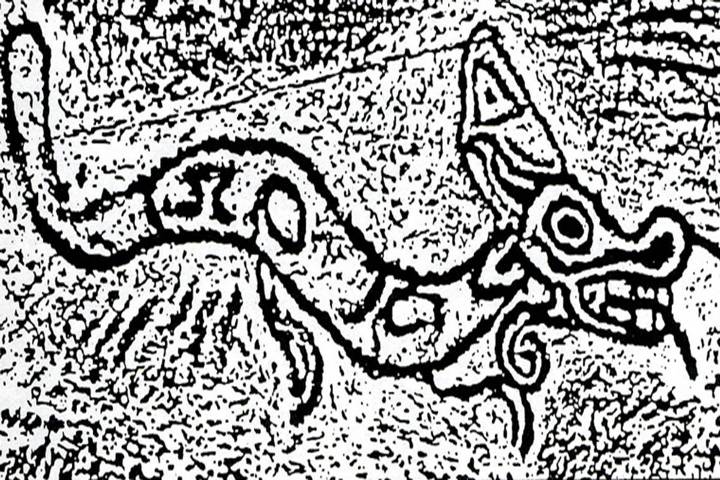Does a creature lurk beneath Cadboro Bay?
Posted by: Craig Woolheater on June 26th, 2018

A sketch made by the Kemp family following their Caddy encounter and published in the Victoria Daily Times in October 1933. (photo/public domain)
Researchers on hunt for Cadborosaurus, with sightings dating back centuries along the B.C. coast
For many, the mention of a group of people dedicated to finding definitive evidence of a legendary sea serpent may evoke an almost reflexive impression of a tinfoil-hat-wearing, fanatic cast of characters; out of touch with reality and certainly not a group to be taken seriously.
In the case of the small cadre of researchers and scientists behind the Caddy Scan Project, that impression would be both unfair and inaccurate.
“You have to start by telling that you are looking at it in a skeptical and scientific basis and, to be taken seriously, you have to establish that you have engaged in serious activities in another field,” explained Dr. Paul LeBlond, one of the researchers with the Caddy Scan Project.
LeBlond holds a PhD in Physics and Oceanography and has published works on the nature of waves, tides and tsunamis. He has worked as a professor and was the past scientific leader in the Ocean Production Enhancement Network. Others within the Caddy Scan Project have similarly impressive credentials.
The Caddy Scan Project has been around since 1999, when VHS cameras were installed at locations of supposed sightings of the Cadborosaurus, more commonly known as Caddy. That’s the name given to a large marine animal that has been sighted by hundreds of witnesses on the coastal waters of the Pacific Northwest.
Recently, those cameras have been upgraded to high resolution DVRs which automatically record any moving objects. While the cameras have not, as yet, recorded Caddy, the motion sensor technology has proven itself capable of capturing larger marine life.
“Caddy sightings are incredibly rare and happen only a few times a year along the entire B.C. coastline so the likelihood of capturing an image is very slight, and until an actual specimen is found, the existence of the creature remains only a possibility, without proof,”said LeBlond.
No specimen has ever been made available for scientific examination and LeBlond says that, until that happens, he will remain skeptical, but curious.
He noted that, for centuries, other oceanic creatures that were thought to be only legend have since been proven to be actually exist.
For example, it’s thought that the gigantic Kraken of legend was actually based upon sightings of a giant squid. For centuries that creature was discounted as no more than myth, but in 1853 a giant cephalapod washed up on a Danish beach and officially entered the annals of science. Many other samples have since been recovered, the biggest of which measured in excess of 18 metres in length.
“With Caddy, there are similarities and detailed accounts of appearance that bear a remarkable consistency. The creature is described as being hairy, with a long neck and, it seems, is mammalian in nature,” said LeBlond.
“We’re talking about close-quarter contacts where people have been very close to the creature. Those accounts seem to have some basis in a real encounters with what we refer to as a cryptid – that is, a creature whose existence has not been proven scientifically but is thought to exist.”
LeBlond discounts the fuzzy photos of the creature taken at a distance as being less than helpful.
“Photos like that could be anything and offer no proof of anything. And every time someone makes a false claim or fakes a photo it makes our work that much more difficult. It actually hurts our credibility.”
In its search for the truth, LeBlond’s group is encouraging anyone who has encountered Caddy to come forward and report the sighting. Information on how to report can be found at cadborosaurus.ca.
LeBlond and his co-authors and researchers, John Kirk and Jason Walton, have also published a book on the subject of Caddy, entitled Discovering Cadborosaurus, in which the legends, facts and fictions of the legendary creature are explored. (The book is available in bookstores or can be ordered through the group’s website.)
“I’ve been curious about this creature since I was an assistant professor at UBC in 1969 and I’m curious still. It’s an interesting puzzle, to be sure,”said LeBlond.
When pressed on whether he truly believes in Caddy’s existence and asked to speculate on what it could be, LeBlond is cautious in his approach.
“The way its movements have been described would lead one to think it may be mammalian, perhaps an unknown, large, long-necked deep-sea seal of some kind … but we really don’t know. Until we have a specimen to examine, it’s just a mystery, and one that we’d love to solve.”

A prehistoric petroglyph from the Monsell site, Nanaimo, B.C. appears to be one of the first depictions of Caddy. (photo / public domain)
About Craig Woolheater
Co-founder of Cryptomundo in 2005.
I have appeared in or contributed to the following TV programs, documentaries and films:
OLN's Mysterious Encounters: "Caddo Critter", Southern Fried Bigfoot, Travel Channel's Weird Travels: "Bigfoot", History Channel's MonsterQuest: "Swamp Stalker", The Wild Man of the Navidad, Destination America's Monsters and Mysteries in America: Texas Terror - Lake Worth Monster, Animal Planet's Finding Bigfoot: Return to Boggy Creek and Beast of the Bayou.









Caddy is a classic sea cryptid with lots of history and lore as well as a solid bank of sightings and eye witness reports.
Dr. Paul LeBlond has put a ton of effort and years into the research and cataloging of Caddy and kudos to him.
It’s one of my favorite USO’s (not to be confused with alien nonsense).
Well, the decomposing carcasses are not at all convincing, and they’re probably the first thing most people think of when they think of Caddy. Nor do I find native legends inherently more valuable as evidence than “Jack and the Beanstalk” is evidence of magic beans; the natives would have to be truly abnormal if, unlike every other group of humans, they never invented any fantastic beasts from their own imaginations. That said, this is NOT Loch Ness, which can be searched rather thoroughly; this is a part of the Pacific Ocean, and perhaps some unusual sea creature spends part of its life cycle in or near Cadboro Bay.
Here is a link to a better picture of the petroglyphs:
https://farm3.staticflickr.com/2884/11970165325_dfd7c562e0_c.jpg
Very interesting in of themselves.
@Mandors — Without knowing the iconography of the culture that produced the carvings, it’s hard to know what they are really supposed to represent, but … it’s hard not to think they look like the imaginary exploits of giant seahorses. Of course, seahorses are not usually found that far north (but see https://news.ubc.ca/2014/05/22/citizen-scientists-spot-rare-seahorse-in-canadian-waters/), but I could imagine them receiving small, dried seahorses in trade and believing traveler’s tales about these being “babies” with the adults being man-sized or larger. At any rate, the shape of the head, the fins on the back, and the weird shape of the tail make these look like seahorses to me.
@Fhqwhgads
You make a solid point that is the basis of both Archaeology and Art History. Works like this are difficult to fully comprehend absent an understanding and knowledge of the creators’ culture. Without this, the analysis often devolves into “Ways of Seeing” BS, driven by the subjectivity (and often agenda) of the beholder.
Interestingly, I did some research years ago into the culture of the native peoples of the Pacific Northwest (totems, myths, imagery, potlatches, etc.), and this may be highly subjective, but these carvings seem very different from the art of peoples I was looking into.
To me, the figures seem lupine, maybe like wolves eating fish. But again, more information is needed.